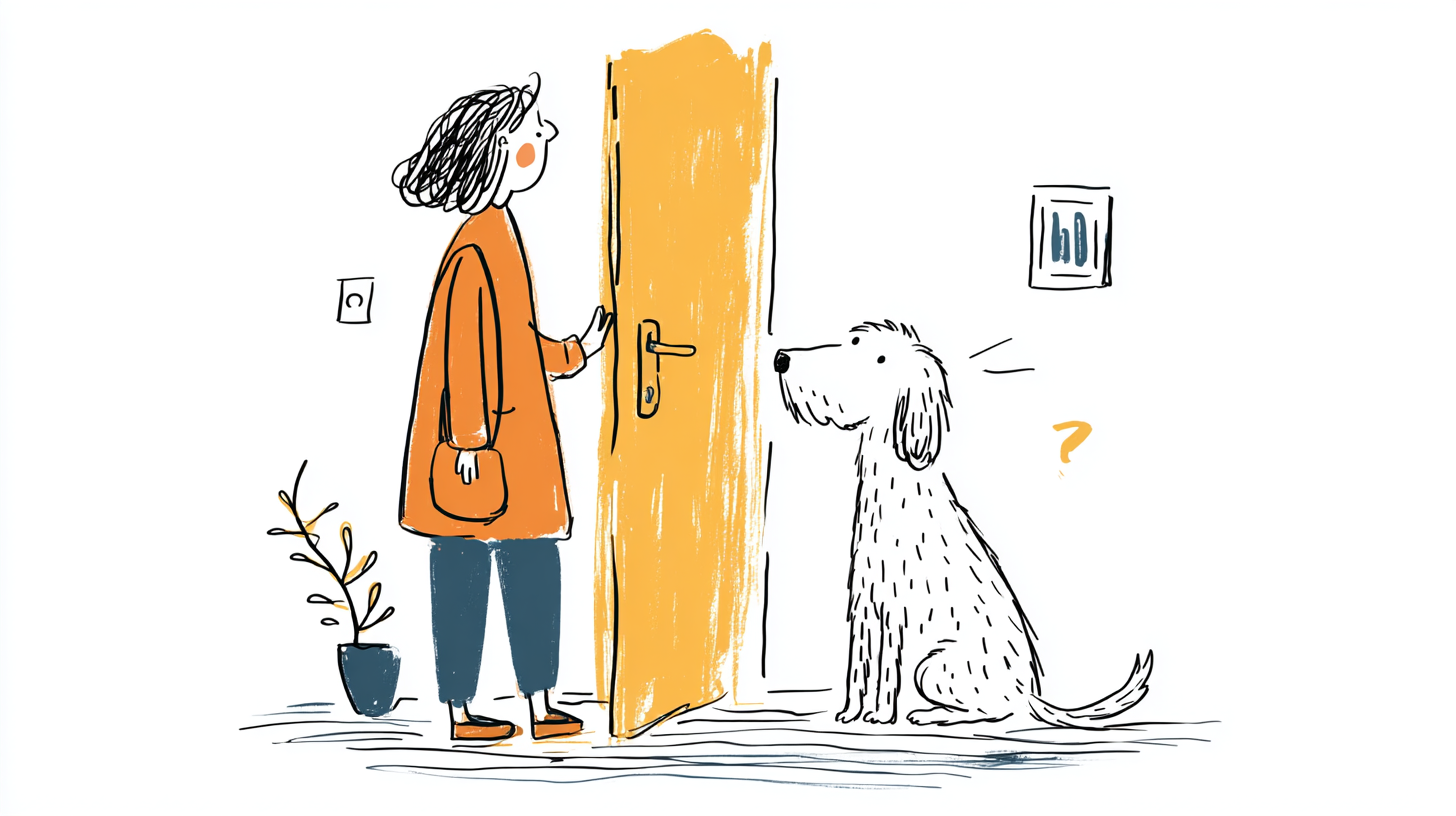Hyper Attachment in Dogs: When Your Velcro Dog Needs More Independence
Does your dog follow you everywhere, even to the bathroom? Do they seem unable to relax unless they're touching you? While we love our dogs' devotion, extreme attachment can signal an underlying issue that needs attention. Understanding hyper attachment – often called "velcro dog" behavior – helps us support our furry friends in developing healthy independence.
What Makes a Dog a "Velcro Dog"?
The term "velcro dog" perfectly captures the essence of hyper attachment. Just like velcro sticks to fabric, these dogs seem magnetically attached to their humans. Common signs include:
- •Following you from room to room, always underfoot
- •Inability to settle unless touching you
- •Constant need for physical contact
- •Distress when you move even slightly
- •Always watching you for cues and direction
- •Difficulty engaging in independent activities
While some closeness is natural and healthy, velcro dogs take attachment to an extreme that can impact both their wellbeing and yours.
Understanding the Causes
Hyper attachment doesn't happen overnight. Several factors can contribute to this clingy behavior:
Breed Tendencies
Some breeds are naturally more prone to velcro behavior:
- •Lap dogs: Bred specifically for companionship
- •Working breeds: Like German Shepherds and Australian Shepherds, bred to work alongside humans
- •Herding dogs: Developed to work closely with humans
These breeds have generations of selective breeding that encourages close bonds with humans.
Learned Behaviors
We often unknowingly reinforce clingy behavior:
- •Petting every time they approach
- •Feeding when they follow to the kitchen
- •Giving attention for persistent following
- •Allowing constant physical contact
Dogs quickly learn that staying close brings rewards.
Life Experiences
Several experiences can trigger hyper attachment:
- •Rescue dogs: Past trauma or abandonment
- •Lack of early socialization: Missed critical development periods
- •Changes in routine: Moving, family changes, schedule shifts
- •Single-dog households: No other canine companions
Age and Health Factors
Senior dogs often become more clingy due to:
- •Vision or hearing loss
- •Cognitive decline
- •Physical discomfort
- •General anxiety about their changing abilities
The Crucial Difference: Velcro Dogs vs. Separation Anxiety
While these conditions overlap, understanding the distinction is vital for proper management:
Velcro Dog Behavior:
- •Wants to be near you when you're home
- •Generally settles when you leave
- •May be initially unhappy but adapts
- •Functions normally in your absence
Separation Anxiety:
- •Panics when alone
- •Destructive or self-harming behaviors
- •Cannot settle throughout your absence
- •Shows physical symptoms of distress
Think of it this way: velcro dogs prefer your company, while dogs with separation anxiety need your presence to function. However, research by Sargisson (2014) confirms that hyper-attached dogs do face increased risk of developing clinical separation anxiety, making early intervention important. This differs from FOMO behavior, where dogs simply don't want to miss out on activities.
Why Hyper Attachment Needs Attention
While having a devoted companion seems harmless, extreme attachment can cause problems:
For Your Dog:
- •Chronic stress: Constant vigilance is exhausting
- •Missed experiences: Too focused on you to explore
- •Lack of confidence: Inability to self-soothe
- •Social difficulties: Trouble bonding with others
- •Increased anxiety risk: More likely to develop serious issues
For You:
- •Restricted movement: Can't move freely in your home
- •Guilt: Feeling bad about normal activities
- •Safety concerns: Tripping hazards from constant following
- •Relationship strain: Partners or family may feel excluded
- •Lifestyle limitations: Difficulty leaving home or planning travel
Building Healthy Independence
The goal isn't to make your dog love you less – it's to help them feel secure and confident, with or without you. Here's how:
1. Create Physical Boundaries
Start with small separations within your home:
- •Use baby gates to create separate spaces
- •Practice "place" or "stay" commands
- •Reward settling at a distance
- •Gradually increase separation time
2. Encourage Independent Activities
Help your dog discover joy in solo pursuits:
- •Puzzle feeders: Mental stimulation during meals
- •Long-lasting chews: Special treats for alone time
- •Interactive toys: Self-play options
- •Sniff games: Hide treats around the room
3. Modify Your Responses
Change how you interact to reduce dependency:
- •Ignore attention-seeking: Don't reward constant following
- •Initiate contact: You decide when to pet or play
- •Practice departures: Leave the room without fanfare
- •Stay calm: Don't make reunions overly exciting
4. Build Confidence Through Training
Structured training builds independence:
- •Place training: Teach relaxation on a mat or bed
- •Distance commands: Practice stays with increasing space
- •Confidence building: New experiences and challenges
- •Impulse control: "Wait" and "leave it" commands
5. Establish Predictable Routines
Structure helps anxious dogs feel secure:
- •Regular meal times
- •Scheduled play and training
- •Consistent alone time practice
- •Predictable daily patterns
A Step-by-Step Independence Plan
Here's a practical approach to reducing velcro behavior:
Week 1: Assess and Prepare
- •Observe current attachment levels
- •Identify triggers and patterns
- •Set up training tools (gates, toys, treats)
- •Start basic place training
Week 2: In-Home Boundaries
- •Practice room separations with gates
- •Reward calm, independent behavior
- •Begin "stay" training with distance
- •Introduce puzzle feeders
Week 3: Building Duration
- •Extend separation periods gradually
- •Add enrichment activities
- •Practice multiple short separations daily
- •Reward independent play
Week 4: Real-World Application
- •Brief departures from home
- •Vary your routine
- •Continue reinforcing independence
- •Monitor progress and adjust
When Professional Help is Needed
Consider consulting a veterinary behaviorist if:
- •Behavior escalates to separation anxiety
- •Your dog shows signs of panic or distress
- •Self-harm or destruction occurs
- •Progress stalls despite consistent effort
- •You feel overwhelmed or unsure
Success Stories and Realistic Expectations
Change takes time, but improvement is possible. Many velcro dogs learn to:
- •Enjoy independent activities
- •Relax in separate rooms
- •Greet visitors appropriately
- •Sleep in their own beds
- •Handle routine separations
Remember, the goal isn't complete independence – it's healthy balance. Your dog can remain loving and bonded while also feeling confident alone.
Maintaining Progress
Once you see improvement:
- •Continue practicing independence skills
- •Don't revert to old patterns
- •Celebrate small victories
- •Stay consistent across all family members
- •Address setbacks promptly
The Bigger Picture
Helping your velcro dog develop independence is an act of love. You're giving them:
- •Emotional resilience
- •Confidence in their abilities
- •A richer, less stressful life
- •Better coping skills
- •Freedom to explore and grow
This journey requires patience, consistency, and understanding. Some days will be harder than others, and progress might feel slow. That's normal and okay.
Final Thoughts
Your velcro dog's clingy behavior comes from a place of love and perhaps insecurity. By gently encouraging independence, you're not pushing them away – you're helping them become their best, most confident self.
Every small step toward independence is a victory. Whether it's your dog choosing to lie on their bed instead of your feet, or calmly watching you leave the room, these moments matter. They're building blocks toward a healthier, happier relationship.
Remember, you're not alone in this journey. Many dog parents face similar challenges, and with the right approach and tools like Separation Buddy, velcro dogs can learn to enjoy both togetherness and independence. Your commitment to helping them grow shows the depth of your love and care.
Keep going, stay patient, and trust the process. Your furry friend is capable of more than you might imagine – they just need your guidance to discover it.

